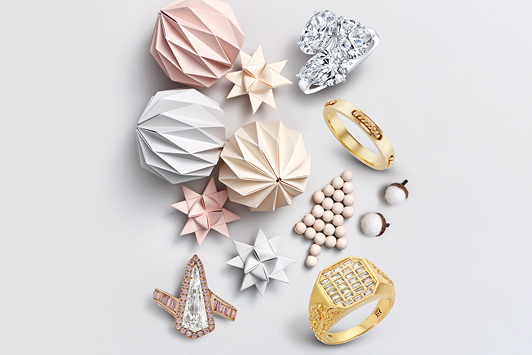 Image: Background: Stocksy; Clockwise from top: Rahaminov Diamonds, Michelle Fantaci, Marvin Douglas, J Fine.
Image: Background: Stocksy; Clockwise from top: Rahaminov Diamonds, Michelle Fantaci, Marvin Douglas, J Fine.
In seasons past, some manufacturers looked to holiday sales to make their year. Now, in our not-quite-post-pandemic world, manufacturers are approaching the holidays having already achieved record-breaking sales. Holiday orders are maintaining that pace thanks to people’s desire to celebrate — especially with diamonds.
“Retailers are ordering the same classic pieces that they have throughout the year,” says David Rakower, president of New York-based manufacturer Joseph Asher Collection. Solitaires, three-stone rings and diamond studs are among his top sellers, and he can even accommodate last-minute orders. “There is always something for everyone, especially if they only need minimum replacement pieces.”
Arch Kitsinian agrees that “diamond classics are always popular.” While “everything is selling across the board,” says the president of manufacturer S.A. Kitsinian and jeweler Vanna K in Lake Balboa, California, diamond studs and tennis bracelets are the bread-and-butter items that are continually in demand.
The same is true for New York-based manufacturer Divina Creations. “We’re selling studs nonstop, and demand far exceeds supply,” reports president Ketan Mehta. He notes particular interest in ones with a total weight of 3 to 6 carats, both with and without Gemological Institute of America (GIA) certification. And while “historically, tennis bracelets sold in the 3- to 5- to even 10-carat range,” he’s now seeing demand for bracelets of 15 carats and larger: “We never had a 25-carat bracelet. Now we have three in the shop.”
Bridal is big
While many couples get engaged over the holidays, the Covid-19 lockdowns may have played Cupid for some. Rakower points to the increased popularity of diamond wedding and anniversary bands. “We’ve been doing a variety of styles, but instead of the typical 7- to 11-stone band, we are making bands with 15 stones, although not a full eternity ring.”
There’s also been a desire to upgrade to larger stones, observes Mehta. In the last two months, he has sold more 3-carat-plus goods than he ever has before.
In the loose-stone category, “anything that is GIA-certified in terms of rounds, ovals and nice elongated emeralds is selling well, especially in the 2- to 3-carat range,” he continues. “If you are between 2% and 3% of the market price, nothing is staying in your safe.” That said, he’s noticed a drop in demand for 1- and 1.25-carat stones, a change he “sadly” attributes to lab-grown diamonds dominating that segment.
However, Rakower, who carries lab-grown, insists that a diamond will sell whether it is natural or not. “Lab-grown diamonds check a lot of boxes. You don’t have to play the game that ‘I’m almost buying a diamond.’ Lab-grown is a very good, [less] expensive option for people who are looking for a specific item with a set budget in mind.”
Piety, personalization and price
In another possibly pandemic-related trend, crosses have become a fashion statement in both all gold and all diamond, says Kitsinian. “‘Have faith, not fear,’ seems to have translated into the types of jewelry customers want,” he explains, adding that in previous seasons, sales of religious jewelry were not as significant as they are now. Bold yellow crosses, often in a diamond-cut texture, are common, with some measuring as wide as 4 inches across.
Kitsinian is also seeing “a lot of Cuban chains for men, which tend to be very heavy and 24 to 26 inches in length.”
Personalization is another key holiday trend driving sales, according to Kitsinian. “People are adding their birthstone to the engagement ring in a throwback to the vintage era,” he says, and some have chosen to accent their diamond crosses by inserting their birthstones in the middle.
In that vein, he reports renewed interest in diamond initials, which offer the additional appeal of an attractive price point: about $600 with the chain.
In terms of pricing, Ketan says he has encountered resistance from retailers in the last few weeks because of supply chain issues. If brick-and-mortar independents have the liquidity, he advises, “they should stock up on the classics — studs and tennis bracelets. I have absolutely no doubt that if they don’t, they’ll wind up paying more in a month.”
Over the last several years, Rakower says, “it is fair to say that items $1,000 and below have been quite popular, [as have] the $7,500 and above. But that mid-range from approximately $2,000 to $6,000 has been tough.”
Angling for normalcy
Signs of in-store activity are slowly reemerging. Some of Rakower’s clients are “reaching out to drive customer appreciation and stage in-store events to reinvigorate their customer base, if with a slightly altered format to ease some of the Covid-19 pressures,” he relates.
Based on incoming orders and on conversations with retail clients, manufacturers anticipate a positive holiday period for all parties.
“It’s not a walk in the park for the retailers,” says Kitsinian. “They still have their struggles and challenges, but they’ll have a good holiday if they are well-stocked. Given how well jewelry is selling, they may increase their inventory because of fear of missing out (FOMO).”
Adds Rakower: “People are happy. They want to get past Covid-19 or to not be dominated by the fear. The consuming public is eager to get out and visit, and the retailer is eager to have them.”
Article from the Rapaport Magazine - November 2021. To subscribe click here.